Animals communicate with each other with the help of their bodies just like we do. And there are certain postures and body signals that let animals show us their emotions and intentions — like a dog that suddenly changes the position of its tail, a hamster that stands on its hind paws, or a parrot that pushes one wing to the side.
We at ViralSection studied some of the behavior of the most popular domestic animals. And we hope that this will help you better understand your pet and avoid possible problems and misunderstandings.
1. A dog
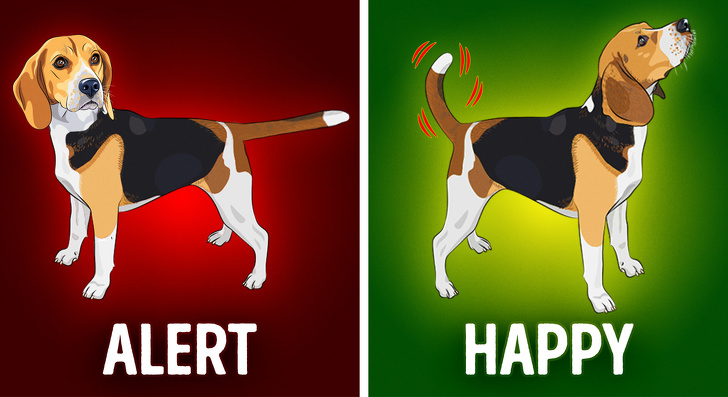
© Depositphotos.com
- Happiness
A curved, wagging tail means that a dog is ready to play and is in a good mood. A dog can tilt its head to the side while trying to listen, waiting for a reward.
- Aggression
The ears are kept forward and upright. The head in this upright position also can indicate aggression or a desire to show dominance.
- Anxiety
A straight, horizontal tail shows that a dog noticed something and is trying to understand if it’s a danger or nothing to worry about.
2. A cat
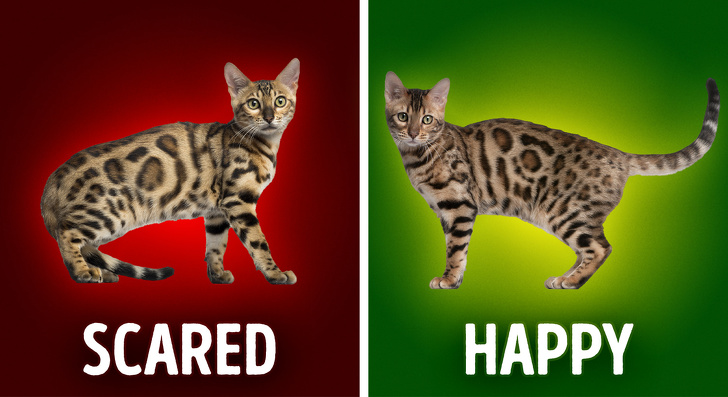
© Shutterstock.com
- Happiness
A calm cat keeps its ears in a relaxed, calm position. If a cat squints or keeps its eyes half-closed, it means that it trusts you and feels safe. When a cat raises its tail, it may mean that it’s happy and friendly.
- Fear
A tail lowered between the paws is a sign of fright and fear. Rounded eyes signal its anxiety. And if a cat quickly moves its ears, then this may mean it’s alert.
- Aggression
A cat can challenge you if it stares at you without interruption. A cat can express aggression when its ears are pressed to its head. And if it sharply and nervously moves the tail up and down or left and right, this indicates its irritation or anger.
3. A hamster
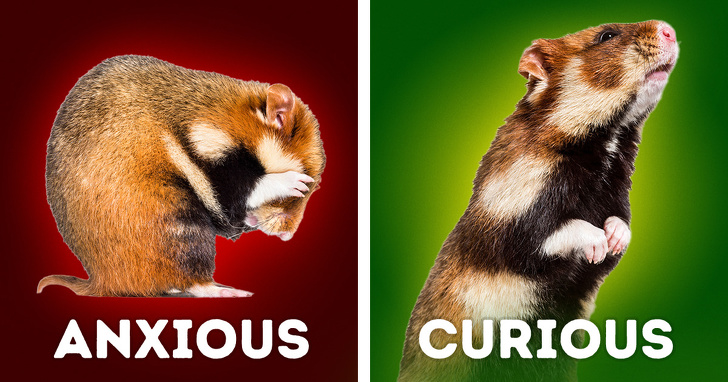
© Shutterstock.com
- Happiness
A hamster can show its satisfaction by yawning and stretching. It expresses joy by jumping. Standing on its hind paws and moving forward with the upper body may signify curiosity.
- Anxiety
If a hamster suddenly begins to wash feverishly, this may signal its concern. It expresses fright when it lies on the floor and sneaks around, trying to hide.
- Aggression
The hamster’s stance on its paws may have another meaning. When it stands on its hind paws but moves back with its upper body, it can signify aggression. It also may raise its front paws up.
4. A rabbit
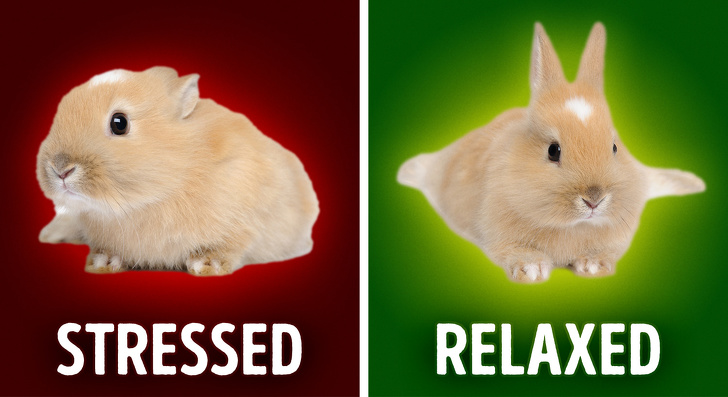
© Shutterstock.com
- Happiness
A rabbit expresses joy by jumping. It shows its good attitude toward you when it lies on its belly and extends their hind and front legs. This means that it feels comfortable and relaxed.
- Anxiety
When a rabbit is tense, it freezes in place. Its ears are pressed to its head and its eyes are wide open. It can take such a pose when it’s dissatisfied with your touch. A knock with its hind legs is a clear danger signal.
- Aggression
When a rabbit is about to bite you, it stands on its hind paws and moves the body forward. Most often, this behavior can be observed in lonely rabbits.
5. A parrot
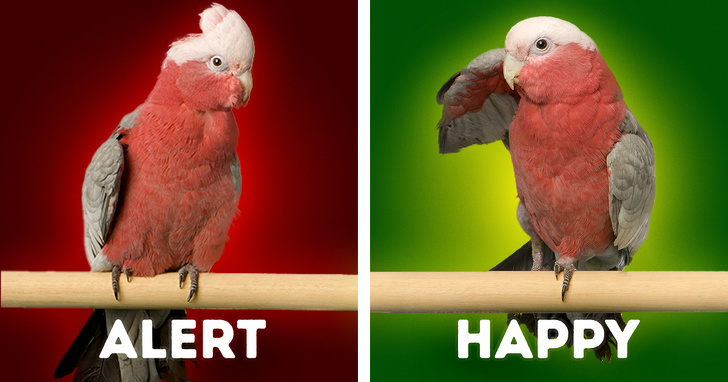
© Shutterstock.com
- Happiness
When a parrot is happy, it can stretch its left wing and leg, and then the right wing and leg. Then, it will pull its wings up. It may also inflate its feathers for a moment.
- Anxiety
A raised crest and a tense body suggest that a parrot is alarmed, scared, and wants to defend itself.
- Aggression
Usually, before attacking and biting you, a parrot takes this next pose. It spreads its legs wide to take a stable position, looks at you, and opens its beak.
6. A guinea pig
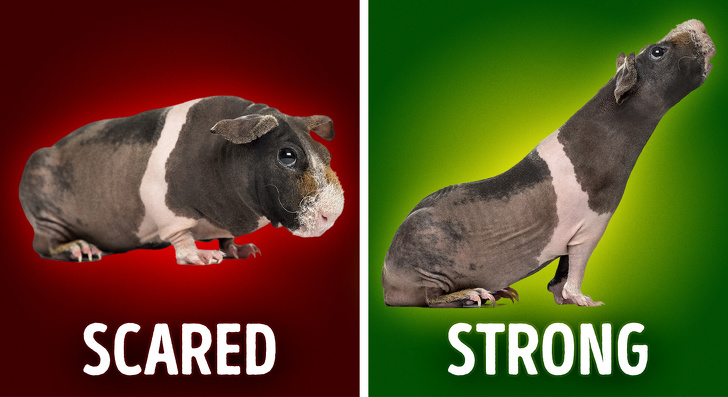
© Shutterstock.com
- Happiness
Jumping up is a sign of a good mood. And if the animal stretches out on the floor and grunts, then it feels comfortable.
- Anxiety
A guinea pig lowers its head when it’s scared. It also presses against the wall or floor, tightening its paws as it freezes.
- Aggression
When a guinea pig shows its strength and wants to make an impression, it pulls its head up. But if it stands on its paws and sways from side to side with a lifted head, it means that it’s set up aggressively.
7. A turtle

© Shutterstock.com
- Happiness
The better and more comfortable the turtle feels, the more actively it explores everything around it with curiosity. It doesn’t hide in its shell and is comfortable showing you its head and paws.
- Anxiety
If the turtle feels threatened, it tries to protect itself by pulling its head, tail, and paws into the shell. It’s a well-known signal that the animal feels fear.
- Aggression
When the turtle wants to show that it’s dominant, it raises its shell as high as possible and extends its tail and neck.
8. A horse
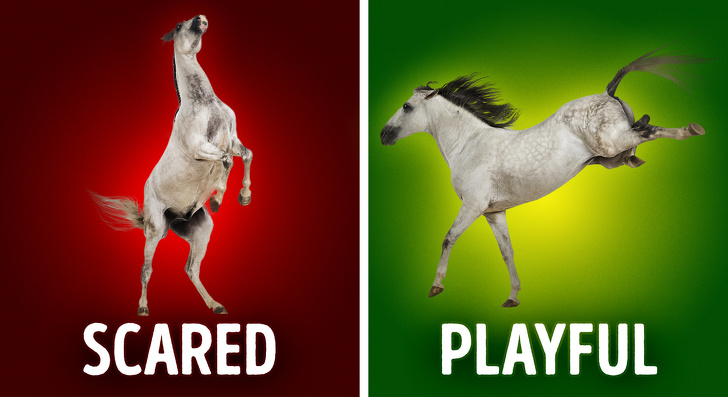
© Shutterstock.com
- Happiness
If this is not the first time you’ve come into contact with the horse, it knows you and raises its hind legs, which can mean that the animal is in a playful mood.
- Anxiety
If a horse raises its front or hind legs, it may mean that it feels threatened or in danger. If a horse is frightened, it’s best to keep a safe distance from it.
- Aggression
When a horse is dissatisfied, it can beat the hooves or forearms on the ground. It can wag its head and tightly press down its ears, pull its tail out, and open its eyes widely.
Do you have any of these animals? Do you easily understand the behavior of your pet? You can describe your relationships with your pet in the comments.
Preview photo credit Depositphotos.com





















